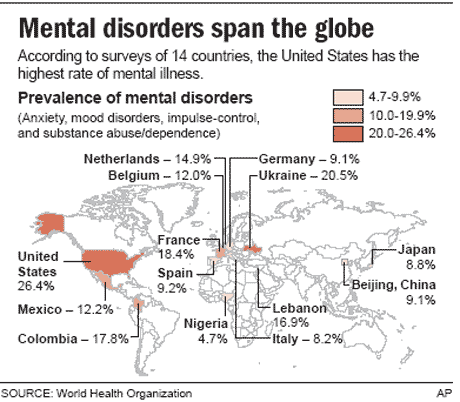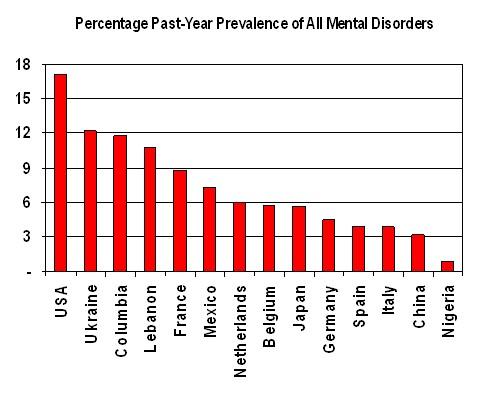Global Outlook
Areas of mental illnesses
How widespread is it?

1/4 of the world population, or 25% percent of all individuals, develops one or more mental disorders at some stage in their life, according to the World Health Organization (WHO). Today, 450 million people globally suffer from mental disorders in both developed and developing countries. 154 million, of these people, suffer from depression, 25 million from schizophrenia, 91 million from alcohol use disorders, and 15 million from drug use disorders.
Mental illnesses don't discriminate; they'll affect anyone - men, women and children - regardless of gender, race, ethnicity, and socio-economic status. Plus, mental health problems represent 5 out of 10 leading causes of disabilities worldwide - amounting to nearly one-third of the disabilities in the world. Depression, bipolar disorder, schizophrenia, substance abuse, and dementia are among the leading contributors.
Finally, every year, as many as 16 individuals for every 100,000 people worldwide commit suicide as a result of some underlying mental problem. In the United States of America, the number is 11 individuals for every 100,000 people. More than 90 percent of people who commit suicide have some or the other diagnosable mental disorder. The mental illness and homelessness statistics reveals that mental illnesses are the third most prominent causes of homelessness for single individuals in the United States of America. Similarly, the children mental illness statistics, compiled by the Department of Health and Human Services, reveals that the estimated number of children suffering from mental disorders lies anywhere between 7.7 million to 12.8 million. Experts are of the opinion that stress and depression are two important factors in which drive a person towards such psychological problems; and, sadly, these two factors have become the characteristic features of the lifestyle that we follow today.
What areas have the highest number of reported mental problems

Mental illnesses, including anxiety disorders and depression, are common and under-treated in many developed and developing countries, with the highest rate found in the United States, according to a study of 14 countries. Many of the cases researched are mild, but 14% of the population has moderate or severe mental illness.
Lifetime prevalence is even higher. About half of all Americans will meet the criteria for some type of mental disorder sometime in their lifetime, with the first onset case usually in their childhood or adolescence.The new studies are based on face-to-face interviews with more than 9,200 English-speaking adults. Homeless people and those in institutions were not included.
The findings showed that during the course of a year, 26% had any mental disorder, including substance abuse. Anxiety was the most common problem, seen in 18% of the participants. Next were mood disorders (9.5%), impulse control problems (9%), and substance disorders (3.8%).
About 40% of those cases were mild, while 37% were "moderate" and 22% were "serious," say Kessler and colleagues. Severity included the degree of disability and suicide plans or attempts.
Researchers also estimated the lifetime prevalence. They say that nearly three in 10 (29%) will develop anxiety disorders at some point in their lives, making it the most common mental illness. Other lifetime estimates were 21% for mood disorders such as depression, 25% for impulse-control disorders, and nearly 15% for substance disorders. That amounts to a 46% risk for any of those disorders, says the study. On average, most people with anxiety and impulse-control disorders develop those problems at age 11.
